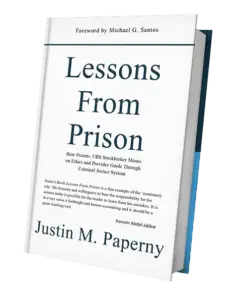Summary
When facing sentencing, understanding how a federal judge thinks can make the difference between a long prison term and a second chance. Earlier this week, I attended a sentencing hearing in Los Angeles. This post captures the full discussion Michael and I had afterward—what we observed, what the judge valued, and how defendants can prepare to present themselves credibly. The takeaway is simple: if you want to influence a federal judge, show your work, not your words.
The Stakeholder Perspective: Seeing Through the Eyes of a Federal Judge
Most defendants walk into court thinking about their own pain—the fear, the shame, the family consequences. But a federal judge sees the situation differently. As Michael explained, judges are stakeholders in the justice system. Their duty is to balance punishment, deterrence, and rehabilitation while protecting the community.
Michael learned from former federal judge Mark Bennett that he was rarely influenced by what prosecutors or defense attorneys said. He expected those arguments. What moved him were authentic, well-prepared statements from defendants who showed accountability, remorse, and progress.
“What influences led him into this position? What did he learn? What is he doing to make things right?” Judge Bennett once said.
If you want to persuade a federal judge, start by seeing the case from their perspective—not your own.
The Federal Judge’s Opening: Privilege and Accountability
At this hearing, the federal judge began with a stark reminder of privilege:
“There are people who come into this courtroom who don’t have your opportunities. I can almost excuse what they did. But I can’t excuse what you did.”
The defendant had wealth, education, and resources. Instead of listing his good deeds, he brought documentation—proof of Alcoholics Anonymous meetings, volunteer work, and service logs. The federal judge described him as “genuine” and appreciated that he acknowledged his advantages.
The lesson? A federal judge isn’t swayed by emotion or self-praise. They’re persuaded by honesty, self-awareness, and evidence of change.
Preparation Speaks the Language of a Federal Judge
Every federal judge understands preparation. Their entire career—from law school to confirmation—was built on proving readiness through effort and evidence.
So when a defendant says, “I’ve prayed and learned my lesson,” that rarely moves a judge. But showing a structured plan, consistent behavior, and supporting documentation does.
“Judges appreciate people who show their work,” Michael said. “That’s what they’ve done their entire lives.”
Preparation earns credibility. A lack of it confirms the cynicism most federal judges already expect.
Building a Record That Persuades Every Stakeholder
The sentencing hearing is just one stop. After that, other stakeholders—probation officers, case managers, Bureau of Prisons staff—continue to influence outcomes. The best mitigation strategy considers how each of them, especially the federal judge, will view your record.
Michael put it this way:
“Influencing your probation officer is a start. Influencing your prosecutor is a start. But the most important person you’ll ever influence is the federal judge deciding your sentence.”
Why a Release Plan Belongs Before Sentencing
Most defendants think a release plan comes after prison. In reality, a federal judge is more likely to grant leniency when that plan is presented before sentencing.
In this case, the defense included a detailed release plan in the memorandum: employment intentions, community service, restitution, and structure. The federal judge could visualize a law-abiding future, not just a remorseful past.
“The justice system has four goals—punish, isolate, deter, and rehabilitate,” Michael explained. “A federal judge wants to know you’ve already started the last one.”
Grading Outcomes: How Federal Judges Think About Results
Probation recommended 36 months; the defendant received 21. Michael uses a grading system that resonates with how federal judges weigh results:
- A: 5–7 months served (through RDAP and earned time credits).
- B–C: Moderate progress.
- D: Minimal mitigation effect.
- F: Full term served.
“The 21-month sentence is the worst case,” Michael said. “But with work and credits, that could become five or six months—an A in a federal judge’s eyes.”
Why the Defendant’s Voice Matters More Than the Lawyer’s
Another key lesson: remorse outsourced through an attorney carries almost no weight. As one federal judge told us, “When a lawyer expresses remorse for their client, maybe one or two percent persuasive.”
A federal judge wants to hear directly from the person who broke the law. Authentic accountability matters more than polished arguments. Your words should align with your documented actions.
The Blind Spot: How Defendants Misjudge Themselves
Michael mentioned Johari’s Window, a sociological concept about self-perception. Many defendants see themselves as good parents or professionals, while a federal judge and prosecutor see a criminal case file. Bridging that gap takes transparency and proof.
A well-crafted mitigation package helps a federal judge see beyond the offense to the individual—if the effort is real.
The Core Principle: Influence Is Built Over Time
This hearing confirmed what we teach at White Collar Advice: you cannot talk your way into leniency before a federal judge. You have to show your way there.
“You cannot change the past,” Michael said. “But you can advance the ball to influence the future.”
That means creating tangible proof: letters, logs, courses, volunteer records, and a release plan that demonstrates who you’ve become. Every federal judge wants evidence that rehabilitation has already begun.
Frequently Asked Questions
What persuades a federal judge at sentencing?
A federal judge is persuaded by evidence—not excuses or empty remorse.
Does a lawyer’s apology help?
Minimal impact. A federal judge wants remorse directly from the defendant, not filtered through counsel.
Why include a release plan before sentencing?
It shows a federal judge that you’ve thought about life after prison and are committed to living lawfully—something few defendants demonstrate.
What documentation helps most?
AA logs, volunteer service records, community letters, and evidence of restitution all strengthen credibility before a federal judge.
How can I build credibility with a judge?
Start early. Build a record, share it with stakeholders, timestamp dates assets are created, the impact of your work, and the steps you are taking to live as a law-abiding citizen.
Justin Paperny, Author of Lessons From Prison and Ethics in Motion



